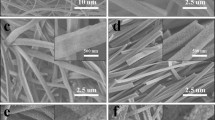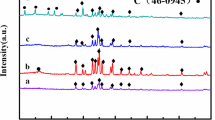Abstract
Iron oxides, including maghemite (γ-Fe2O3) and magnetite (Fe3O4), have been widely applied in many fields. For technological advances in the future, further improvements of their ferromagnetic properties are desirable. The development of iron ferrites with a large coercive field (Hc) is one of issues of consequence. For ferrites, however, enlarging the Hc value is not easy because of their low magnetocrystalling anisotropy constant. Here we report single-crystalline Cu-doped γ-Fe2O3 nanowires in which the controlled diameter (70–100 nm) and the graded Cu dopant (7, 10, and 15%) are directly obtained by a simple chemical vapor deposition technique. In particular, the coercive value (over 2 T) of 10% Cu-doped γ-Fe2O3 nanowires is much higher than that (<80 Oe) of undoped γ-Fe2O3 nanowires at room temperature. On the basis of the experimental magnetization data, the achievement of such a higher coercive field of Cu-doped γ-Fe2O3 (10%) nanowires is tentatively suggested.




Similar content being viewed by others
References
O. Ishii and M. Sencia: High coercivity and high wear-resistance gamma-Fe2O3 thin-films. J. Appl. Phys. 77, 5828 (1995).
J. Jin, K. Hashimoto, and S. Ohkoshi: Formation of spherical and rod-shaped epsilon-Fe2O3 nanocrystals with a large coercive field. J. Mater. Chem. 15, 1067 (2005).
J. Jin, S. Ohkoshi, and K. Hashimoto: Giant coercive field of nanometer-sized iron oxide. Adv. Mater. 16, 48 (2004).
N. Lu, X. Song, and J. Zhang: Crystal structure and magnetic properties of ultrafine nanocrystalline SmCo3 compound. Nanotechnology 21, 115708 (2010).
H. Kronmuller: Recent developments in high-tech magnetic materials. J. Magn. Magn. Mater. 140–, 25 (1995).
P. Dutta, A. Manivannan, M. Seehra, N. Shah, and G. Huffman: Magnetic properties of nearly defect-free maghemite nanocrystals. Phys. Rev. B 70, 174428 (2004).
V. Kusigerski, M. Tadic, V. Spasojevic, B. Antic, D. Markovic, S. Boskovic, and B. Matovic: High coercivity of gamma-Fe2O3 nanoparticles obtained by a mechanochemically activated solid-state displacement reaction. Scr. Mater. 56, 883 (2007).
M. Morales, S. Veintemillas-Verdaguer, and C. Serna: Magnetic properties of uniform gamma-Fe2O3 nanoparticles smaller than 5 nm prepared by laser pyrolysis. J. Mater. Res. 14, 3066 (1999).
L. Li, J. Ding, and J. Xue: A facile green approach for synthesizing monodisperse magnetite nanoparticles. J. Mater. Res. 25, 810 (2010).
D. Chicot, F. Roudet, V. Lepingle, and G. Louis: Strain gradient plasticity to study hardness behavior of magnetite (Fe3O4) under multicyclic indentation. J. Mater. Res. 24, 749 (2009).
E. Tronc, C. Chaneac, and J.P. Jolivet: Structural and magnetic characterization of ε-Fe2O3. J. Solid State Chem. 139, 93 (1998).
Y. Tseng, N. Souza-Neto, D. Haskel, M. Gich, C. Frontera, A. Roig, M. Veenendaal, and J. Nogues: Nonzero orbital moment in high coercivity ε-Fe2O3 and low-temperature collapse of the magnetocrystalline anisotropy. Phys. Rev. B 79, 094404 (2009).
Y. Ding, J. Morber, R. Snyder, and Z. Wang: Nanowire structural evolution from Fe3O4 to ε-Fe2O3. Adv. Funct. Mater. 17, 1172 (2007).
S. Sakurai, A. Namai, K. Hashimoto, and S. Ohkoshi: First observation of phase transformation of all four Fe2O3 phases (γ → ε → β → α-Phase). J. Am. Chem. Soc. 131, 18299 (2009).
J. Lai, K.V. Shafi, K. Loos, A. Ulman, Y. Lee, T. Vogt, and C. Estournes: Doping gamma-Fe2O3 nanoparticles with Mn(III) suppresses the transition to the alpha-Fe2O3 structure. J. Am. Chem. Soc. 125, 11470 (2003).
S. Chakrabarti, S. Mandal, and S. Chaudhuri: Cobalt doped γ-Fe2O3 nanoparticles: Synthesis and magnetic properties. Nanotechnology 16, 506 (2005).
A. Bensaoula, C. Chu, P. Hor, A. Ignatiev, J. Liu, R. Meng, A. Mesarwi, J. Richardson, C. Ting, Y. Wang, and J. Wolfe: A study on Hc-enhancement in co-modified γ-Fe2O3. J. Magn. Magn. Mater. 54–, 1697 (1986).
O. Helgason, J. Greneche, F. Berry, S. Morup, and F. Mosselmans: Tin- and titanium-doped gamma-Fe2O3 (maghemite). J. Phys. Cond. Mater. 13, 10785 (2001).
M. Deng, T. Chin, and F. Chen: Fine structure and magnetic properties of Mn- and Co-doped nanocrystalline γ-Fe2O3. J. Appl. Phys. 75, 5888 (1994).
Y. Zhu and C. Li: Materials science communication effect of doped silicon on structure and magnetic properties of γ-Fe2O3 particles. Mater. Chem. Phys. 51, 169 (1997).
D. Tripathy, A. Adeyeye, C. Boothroyd, and S. Shannigrahi: Microstructure and magnetotransport properties of Cu-doped Fe3O4 films. J. Appl. Phys. 103, 07F701 (2008).
Q. Yao, W. Liu, X.G. Zhao, and Z. Zhang: Structure and magnetic properties of Cu-doped SmCo6.7−xCuxCr0.3 magnets. J. Appl. Phys. 102, 093905 (2007).
W. Li, T. Ohkubo, T. Akiya, H. Kato, and K. Hono: The role of Cu addition in the coercivity enhancement of sintered Nd-Fe-B permanent magnets. J. Mater. Res. 24, 413 (2009).
A. Hussein, P. Murugaraj, C. Rix, and D. Mainwaring: The influence of Sb doping in achieving high magnetic coercivities in CoPt nanoparticles for micromagnet applications. J. Mater. Res. 24, 499 (2009).
N. Yoshikawa, Z. Cao, D. Louzguin, G. Xie, and S. Taniguchi: Micro/nanostructure observation of microwave-heated Fe3O4. J. Mater. Res. 24, 1741 (2009).
A. Zhu, X. Luo, and S. Dai: Chitosan-poly (acrylic acid) complex modified paramagnetic Fe3O4 nanoparticles for camptothecin loading and release. J. Mater. Res. 24, 2307 (2009).
R. Ianos: An efficient solution for the single-step synthesis of 4CaO·Al2O3·Fe2O3 powders. J. Mater. Res. 24, 245 (2009).
S. Zhou, X. Zhang, H. Gong, B. Zhang, Z. Wu, Z. Du, and S. Wu: Magnetic enhancement of pure gamma Fe2O3 nanochains by chemical vapor deposition. J. Phys. Cond. Mater. 20, 075217 (2008).
Acknowledgments
This work was partially supported by the Program for Science & Technology Innovation Talents in Universities of Henan Province (No. 2008 HASTIT002), Innovation Scientists and Technicians Troop Construction Projects of Henan Province (No. 094100510015), and by the Natural Science Foundation of China under Grant No. 20971036.
Author information
Authors and Affiliations
Corresponding author
Rights and permissions
About this article
Cite this article
Zhou, SM., Lou, SY., Wang, YQ. et al. Preparation of Cu-doped γ-Fe2O3 nanowires with high coercivity by chemical vapor deposition. Journal of Materials Research 26, 1634–1638 (2011). https://doi.org/10.1557/jmr.2011.129
Received:
Accepted:
Published:
Issue Date:
DOI: https://doi.org/10.1557/jmr.2011.129




